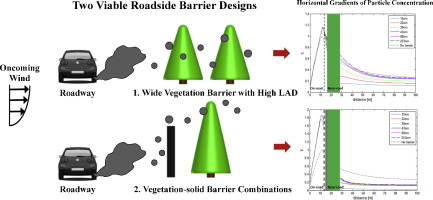Vegetation in urban environments can create complicated flow patterns which are difficult to take into account for many models. However, the potentially large effect on air quality due to vegetation necessitates accurate modeling of this common urban feature.
In an exploratory study, we simulated the effects of vegetation barriers on near-road particle size distributions characterized by a field experiment, and examined the knowledge gaps in capturing the impacts of dispersion and deposition, as well as proposed several recommendations on how to bridge those gaps [1].
In a more recent study, we evaluated the performance of the CTAG model with Large Eddy Simulation (LES) to capture the effects of vegetation barriers on near-road air quality, compared against field data [2]. Then, CTAG with LES was employed to explore the effects of six conceptual roadside vegetation/solid barrier configurations on near-road size-resolved particle concentrations, governed by dispersion and deposition. Two potentially viable design options are revealed: a) a wide vegetation barrier with high Leaf Area Density (LAD), and b) vegetation–solid barrier combinations, i.e., planting trees next to a solid barrier [2]. Both designs reduce downwind particle concentrations significantly.
Related Publications
1. Steffens, J. T., Wang, Y. and Zhang, K. M., Exploration of effects of a vegetation barrier on the dispersion of pollutants in a near road environment. Atmospheric Environment, 50: 120-128, 2012
2. Tong, Z.; Baldauf, R. W.; Isakov, V.; Deshmukh, P.; Zhang, K. M. Roadside vegetation barrier designs to mitigate near-road air pollution impacts. Science of the Total Environment 541: 920-927, 2016

